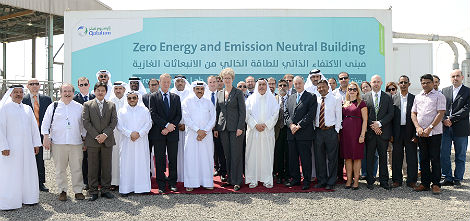Qatalum and Hydro – the Norwegian aluminium producer – have together unveiled Hydro’s newly established facility dedicated to researching and testing aluminium used in curtain wall solutions in support of creating energy, emission and carbon neutral buildings in the Middle East.
The Zero Energy and Emission Building lab is located on site at the Qatalum smelter and was officially opened on 18th Mar 2013 by Hilde Merete Aasheim, the Vice Chairman of Qatalum and the Executive Vice President of Hydro. Also present were the CEO and DCEO of Qatalum.

Speaking at this event, Hilde M Aasheim said: “Today, around 40 per cent of the world’s energy consumption is related to cooling and heating of the buildings we work and live in. Hydro has delivered solutions in aluminum to a large number of energy-efficient and energy-positive buildings. If by using various certain devices the temperature immediately inside the curtain wall can be lowered by 1 degree Celsius, there will be a saving of 5-10 percent in terms of energy used for air conditioning. Delivering such solutions requires high competence, and the solutions will to a large degree depend on the climate where you are.”
The inauguration ceremony continued at Qatar Science and Technology Park, where Hydro has established a Technology Centre. A seminar was organized at QSTP with key speakers from the Aluminium Industry.
Opening the event at QSTP, Dr Chris Devadas, Head of the Technology Centre, welcomed the delegates and highlighted the research and technology undertaken at this centre. Underscoring the importance of Hydro and Qatalum in driving research and bringing international best practice to the region, Devadas argued that Hydro Technology Centre “will build up competence and cooperation with other institutions in Qatar in important areas that impact the global climate”.
“Research will be conducted to make assessments of the impact of the Middle East Climate on Building Envelopes and how building envelopes can be developed to influence the long term sustainability of buildings. The Zero energy emission facilities facility will enable us to provide environmentally sustainable products and knowledge on options for building design and layout. It will allow us to investigate room conditions, like indoor air temperature, relative indoor air humidity and air velocity and, out of the measured data we can then determine the energy consumption of a building using the tested curtain wall solution”, he said.
Qatalum’s CEO Tom Petter Johansen made a compelling presentation on the role of Aluminium as a part of the solution to climate change: “A zero energy building is a building with zero net energy consumption and zero carbon emissions annually. While no such building currently exists in Qatar, the potential to achieve this is great.”
He added: “The zero-energy goal is becoming more practical as the costs of alternative energy technologies decrease and the costs of traditional fossil fuels increase. This is supported by the progress made in new energy and construction technologies and techniques, as well as vastly improved research, which collects precise energy performance data on traditional and experimental buildings and provides performance parameters for advanced computer models to predict the efficacy of engineering designs.”
Johansen gave various examples of how Aluminium has been used to provide elegant solution to the complex and urgent issue of climate change.
Addressing attendees, Mr Jean-Marc Luvisutto, General Manager Technical Middle East said: “In Europe, Hydro already supplies aluminium solutions to reduce energy consumption by implementing smart facade systems, which can significantly reduce the need for heating or cooling. However, high temperatures combined with air humidity, sand and very high solar radiation – provides one of the most demanding climatic conditions for buildings and its materials, and that there is currently only limited data and research available regarding the performance of different solutions under these climatic conditions”.
“The aim of The Zero Energy and Emission Neutral Building is to increase knowledge on the use of different curtain wall solutions in the Middle East, where the potential for energy savings in buildings is untapped”, he added.
The ZE²B Research Laboratory consists of two independently operated test containers and a detached chiller station. Each of the two test containers has two test chambers embedded, which represent a single office room. In the area of the building envelope the test containers have an opening allowing the installation of different curtain wall solutions. Each test chamber itself can be individually cooled, artificially lighted, mechanically and naturally ventilated.
The research lab can analyse four different curtain wall solutions in parallel allowing mainly qualitative comparison between the options. In addition, the facility is equipped with specialist equipment to test solar thermal and photovoltaic applications. It is expected to operate for several years, during which test data will be collected and analysed.
In the Q and A session, apart from questions regarding the lab’s capabilities and cooperation with local institutions, there was marked interest in understanding the strategy that Qatalum was adopting towards the expansion of Aluminium downstream activities in Qatalum. Discussion surrounded how, as a leader in operational excellence, high-quality aluminium products and environmental performance in the Gulf, Qatalum is actively working towards a future where the combination of Qatalum’s primary aluminium production and other Qatari firms’ utilisation of the aluminium to create value-added products, resulting in Qatar becoming one of the main centres of aluminium trade and production, not only in the region, but in the world.

